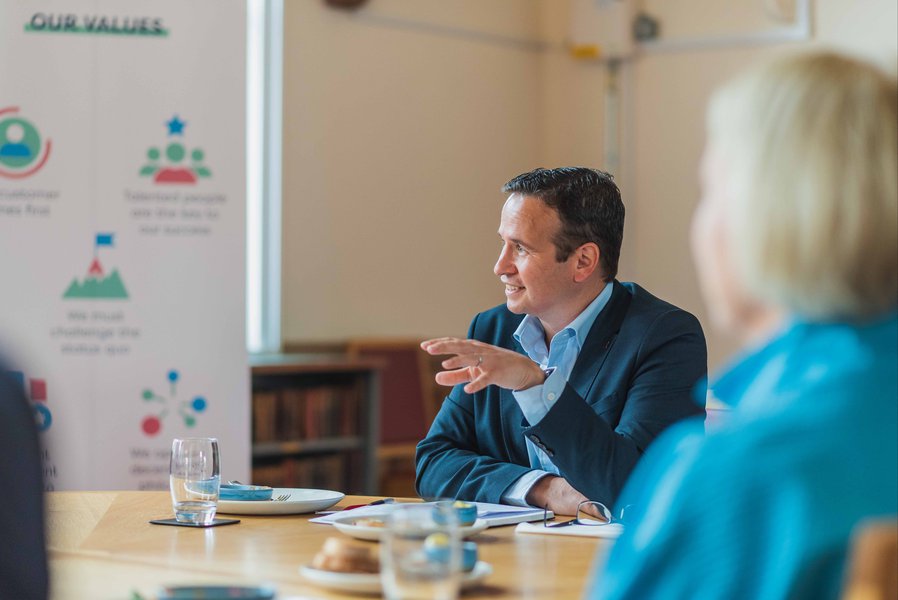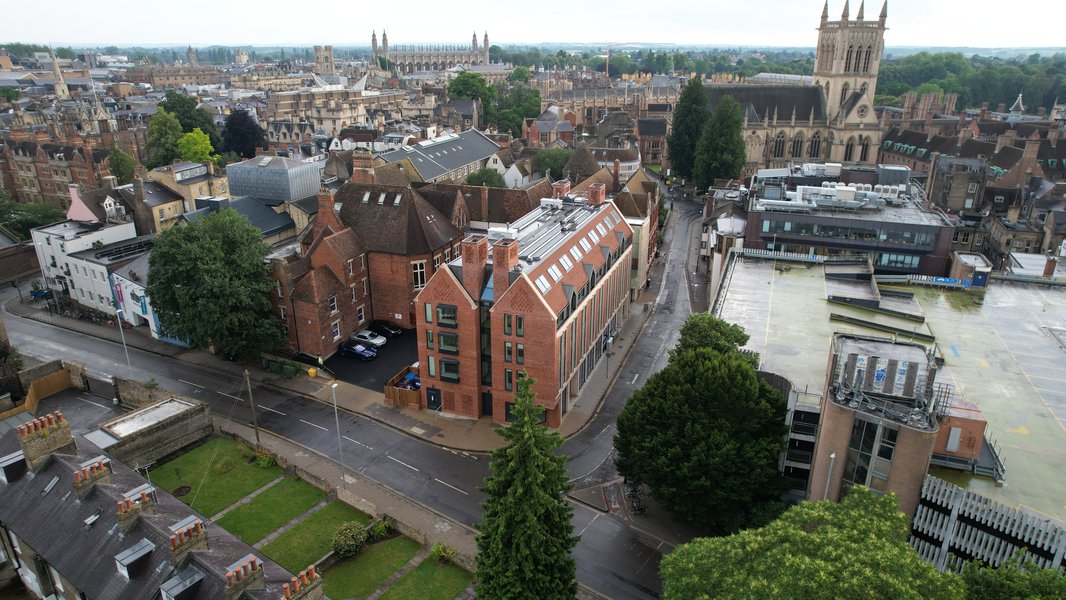Two years after joining Morgan Sindall Construction as area director for our Cambridgeshire business, we sat down with Jamie Shearman to see what the journey had been like for him.
You’ve been in post for two years, what has the change been like for you?
Actually, the truth is, it was great because I was made to feel very welcome. Ahead of joining I had a series of meetings with colleagues, so I knew a lot of people before I started. Don’t get me wrong, it was daunting, especially in the midst of the lockdown, but I never felt anything other than supported.
What did you do before this role?
Before taking this role, I was a preconstruction director with Wates and had various roles there in work-winning departments, so that’s been a really good grounding as there are so many skills that work winning teams have to deploy. However, I was in a national role, so moving to a dedicated focus for Cambridgeshire has meant getting more into the detail across lots of functions.
Has that been a positive change then?
Yes, absolutely – I love getting into the detail. The sense of ownership you get from a role like this is empowering. I much prefer it and feel like I can positively and directly affect things. It means I can get in amongst the work winning, but then see that through to construction, completion and after care – so we’re really focused on those whole-life-cycle relationships. You have up’s and down’s but despite the challenges, it’s been absolutely brilliant.
What’s your take on Morgan Sindall Construction now?
Whilst I’m really supported, the decentralised approach is something really different – it means the Cambridge business really is ours to lead locally, and we can have real influence to innovate, grow our talent and make a difference to people’s live in the communities we live and work. It’s totally in our hands, but the support if we need it is tremendous.

You started in COVID – how hard was it to connect and how did you overcome that?
It’s difficult to gauge the level of challenge as I had no barometer for this. My first week was back-to-back Teams calls. It got us through the tough times, but it isn’t anywhere near the quality of conversation you can have face to face. You miss proper eye contact, body language and getting to know people properly, I think. I did miss that connection with the people.
However, I did visit our projects, and was really proud of the incredible work they continued to deliver. I know the whole industry stepped up and it was a proud moment to see us doing it too.
We’ve moved back to a more hybrid way of working and its great to be doing many of the things we could do before the pandemic. We had our family day in summer 2021 and our staff briefing moves back to in-person in June, so I’m really excited for that. What people in this business have done over the last two years has been incredible and I want to see them in-person, to thank them for that.
What’s the biggest challenge you faced and how did you overcome it?
I think for us it was the disconnection in the market’s perception around the diverse array of projects we can do. Historically we had delivered a lot of schools – and these are still really important to us, but I also wanted to see us spread our wings again and tap into the expertise our people had across other sectors like life sciences, residential, commercial and other education sub-sectors like the Universities and Colleges. To overcome this our team has been getting out and meeting people, providing technical advice and showing them what we can do, and this has definitely started to effect change in perception.
We also changed our internal project review meetings and put a time limit on them – they’ve become listening sessions, where questions are encouraged, and constructive challenge is the limit. It’s helped create a really trusting and open place for innovating on our projects and the results and feedback has been great.

What do you want to see from your ‘brand’ now in Cambridge?
So ultimately, I want people to see that we have technically excellent people, but that we are a company that is easy to work with, that you can trust. And the latter being the most important factor. Designing and constructing complex buildings means sometimes you have to have difficult conversations, but we’ve grounded our culture with an openness, so that customers know they can trust us. That’s really important to me. We have some great relationships at the moment, but I will stress we’ve still got a long way to go – I want to be creating great experiences for every customer, and we’ll be giving everything we have to get there.
Looking back over the last two years what has been your biggest success?
Re-energising the team has been a big success, and we’ve developed the culture here as well. We’ve diversified the sector mix now, so we’re working in the research, residential and healthcare markets as well as delivering education projects. It’s really enabled some of our talented people to shine – one of teams recently had to deliver a complex mental health project with four rigid handover dates, and they achieved each one. I’m so proud of them not only for delivering on time, but for making it a great experience for the customer as well. Our staff survey results showed that there was a 99% satisfaction rate from Cambridgeshire staff, so that fills me with confidence that our team here are going to continue delivering for our customers.
What opportunities do you see in the Cambridgeshire and Peterborough markets?
I think there’s exciting opportunities here; Cambridge continues to attract development and bringing families in and in Peterborough, they’re having a real resurgence around their new University, as well as the overall redevelopment plans for the city. Phil Spencer just published a report stating it’s the cheapest place to live within reasonable commute to London, so that may be something that the city can harness to provide further catalyst for growth.
All our customers are wrestling with how to deliver low carbon buildings, and we’ve had so many positive conversations – whether its heritage buildings or new laboratories. We’re actually using our carbon calculator tool CarboniCa to look at life cycle costs for a project we’re currently in second stage with – it’s enabling us to look ahead, make changes according to the modelling and see how that affects whole-life carbon as well as cost. It means we can be far more strategic about how we deliver low carbon buildings for our customers.
What are your hopes for the future of construction?
Locally, I want consistently great delivery for our customers and empowerment of our talented people – these two are intrinsically linked.
As for construction UK plc…we need to start trusting each other more, there needs to be more of a level playing field for everyone involved (from supply chain, right through to investors) – we’re all equal. We only deliver these incredible projects because of everyone – so deeper and more ‘horizontal’ integration of everyone involved will be so important for our industry. Whilst we’re making steps towards a more inclusive industry, we must do more – the work we’re doing now must continue to develop so that we can benefit from the diversity of talent and ideas in the years ahead. It would be great if we could all become instinctively inclusive, whereby its not headline news, it just happens. And that goes for our response to climate change as well – Net Zero and sustainability needs to become like breathing in that we just do it.
Finally, what five key learnings would you share from your two years?
- Invest time in your people, empower and motivate them – they will deliver great things
- Be courageous enough to know you don’t know it all and be comfortable with that
- Listen to the people around you that have the expertise and experience, they will lift you up
- Stay level – it’s really easy to go on the massive highs and lows, but you must stay level
- Look after yourself – for me to take care of others, I also need to take care of myself – you need time to sharpen the saw, so you can be at your best for others



